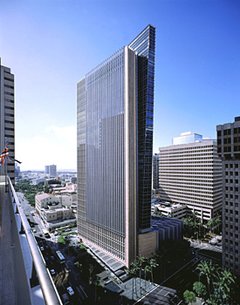First Hawaiian Center
|
|
- For an article about First Hawaiian Tower on 1132 Bishop Street in Honolulu, Hawaii, go to Hawaii Pacific University.
First Hawaiian Center is the tallest building in the City & County of Honolulu and the State of Hawaii. Located at 999 Bishop Street in downtown Honolulu near Bishop Park, the First Hawaiian Center is the world corporate headquarters of First Hawaiian Bank, Hawaii's oldest bank and multi-billion dollar company established by Charles Reed Bishop, consort of Princess Bernice Pauahi Bishop.
First Hawaiian Center features the 24,000 square feet (2,200 m²) of open plaza, park space and waterways in the middle of downtown Honolulu's financial district cityscape of towering commercial buildings and congested streets. It is within walking distance of the Ali'iolani Hale, Cathedral of Our Lady of Peace, Hawaii State Capitol and Iolani Palace. Considered a "unique marriage of commerce and the arts," First Hawaiian Center features three floors devoted to the Contemporary Museum for an art gallery of local Hawaiian works.
Development
First Hawaiian Center was completed and opened in 1996 by Chairman and Chief Executive Officer of First Hawaiian Bank Walter A. Dods, Jr. With over 645,834 square feet (60,000 m²) of space and a height of 429 feet (131 m), the building cost over USD $175 million to construct. The architects were from the firm Kohn Pederson Fox Associates, famous for building the Sothebeys's Worldwide Headquarters and the World Bank Headquarters. They are currently building the Shanghai World Financial Center, the world's tallest building when completed.
Architecture
First Hawaiian Center planning was met with controversy as Hawaii residents became concerned about the effect skycrapers would have on the natural beauty of the Hawaiian landscape. Architects compromised with the use of Hawaiian architectural principles used in most contemporary Honolulu urban projects like those employed by architects of the Hawai'i Convention Center. Metaphoric designs were used in reference to natural phenomena found in Hawaii.
Two distinct architectural forms resulted in the compromise, one for the makai side facing the ocean and one for the mauka side facing the mountains. Horizontally louvered windows framed views of the sea and the horizon while vertically proportioned windows faced the mountains. A great deal of effort was made to incorporate as much natural light into the building interiors.
Resources
- BancWest Corporation (http://www.bancwestcorp.com/)
- BNP Paribas Bank (http://www.bnpparibas.com/en/home/default.asp)
- First Hawaiian Bank (http://www.fhb.com/index.htm)
- Kohn Pedersen Fox Associates (http://www.kpf.com/)


